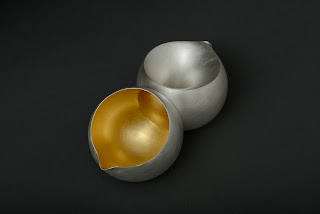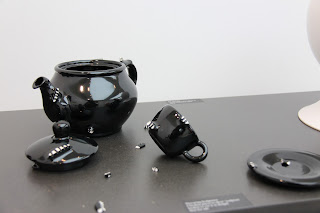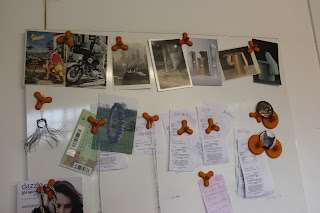Until the 20th of
October 2012, Contemporary Applied Arts Gallery in London is hosting an
exhibition called “Domestic matters” (website).
Simultaneously they have a Focus exhibition featuring three artists. Among them
is Adi Toch, a silversmith dubbed “One of
the most exciting young makers“ by Corinne Julius in the Evening
Standard. I met Adi when I was studying for my MA and, I have been keeping up
with her work since then.
Adi Toch completed her MA at the
Cass, London, in 2009 following her BA with First Class Honours from Bezalel
Art Academy in Jerusalem. Since then her work has been exhibited
internationally and is included in the permanent collections of The Goldsmiths’
Company, Crafts Council and Fitzwilliam Museum Cambridge.
Adi exhibiting at Goldsmith’s in 2010
I am a big fan of Adi’s work and
every time she shows new pieces I tell myself: “wow, she did it again”… But what exactly is she doing? To try and understand this attraction,
I interviewed her in her workshop and also asked a few people to tell me what they
felt about Adi’s work during the private view of the CAA’s exhibition. “I want to touch it”, “it is beautiful”, “I want to hold it in my hands”, “it is very original” were amongst the comments I heard that
evening.
There are some pictures of her
work, beginning with her “tactile series”, as it is where everything started.
Red sand bowl, 2010. Photo: Sussie Ahlburg
Those bowls are made of silver or
other metals and they are especially designed to contain substances, which
cannot be retrieved. In her website Adi writes: ”The series of tactile vessels invites the observer to touch, play and
discover unexpected sounds and motion. Turning the vessels around triggers both
compelling sound and mesmerizing fluidity of the particles held inside like
tiny pearls, sand or ball bearings. The contained particles cannot fall out due
to the special structure”.
This series started
with a “happy mistake” as Adi calls
it. She was participating in a one-week workshop in the Czech Republic “Bohemian
Paradise” area, where precious
stones are found and she described to me how there were lots of little garnet
stones on the benches carelessly stored in plastic cups. Adi was amazed
to see how they were treated like coarse gravel and stored in disposable
containers. She loved the fluidity caused by this type of grouping in large
quantities. She wanted to find a way of setting the stones but at the same time
giving them some freedom of movement. And came this amazing shape, which is now
recurrent in some Adi’s work.
A pinch of salt, 2008. Courtesy of the artist
This gold plated “Pinch of salt”
piece uses the same idea but this time the hole allows two fingers to grab a
pinch of salt.
Adi’s pieces usually start with a
shape and not with a function in mind. She makes a quick drawing and moves
strait to the metal, starting from very basic forms. She lets the shape develop
so the object grows when making it, the metal sometimes “tells” her where to go
as she describes. She doesn’t like the word inspiration but she reckons that
she collects a lot of objects or bits of things in her cupboards. They are somehow
stored in her mind as well and they reappear randomly when she works on a
piece. Two things are always present in her work: containers and tactility…
Sound vessel, 2009. Photo: Sussie Ahlburg
This picture summarizes perfectly
what one is tempted to do when seeing her work: hold it in your hands and
cuddle it. “My intention is to provoke
interactions,” says Adi. And it really works: the round shapes are inviting,
the size fits perfectly in your palms and the matt surface makes it
irresistible. Adi is fascinated by the idea of capturing the inside and outside
by creating vessels and containers. Watching her 18 months old daughter playing, endlessly filling and emptying all kinds of vessels
at home is very inspiring too as it reminds her how
our early world was defined by this simple task of testing how to contain
things. For Adi, a room is a container and the palm of your hands or the body
are imaginary containers.
Body Autobiography. Ear. Courtesy of the artist
This piece is an early work done
during her BA in Israel, but it revolves already around the concept of
containers. Here a plaster mould has been made trapping the gap created between
the head and the shoulder and then Adi has raised the form in metal by hand.
This project was very personal and intimate but it started her reflection about
inside/outside and her love for working with metal as well.
When asked if she could work with
another material, Adi says she is really open but she seems to have developed a
very intimate relation with metal. She likes the idea that metal has character:
“It is like an old friend” she says, “you expect what will happen next but at the same time you might be surprised”.
She also loves the fact that metal becomes warm when you hold it in your hands
and reverts to cold when you leave it aside. “It is like fresh linen in your bed. The first impression is coolness
and progressively it takes the temperature of your body”.
Oil drizzler, 2012. Photo: Sussie Ahlburg
When asked about techniques and
how important they are, Adi considers that they are only here to serve the
shape she wants to make. The piece above shows how skilled she is, but that is
not her technical skills she wants to advertise. I have seen her at work, and I
found the finish of her pieces particularly interesting: she can spend hours
removing the fire stain (NB: when heated and soldered, a layer of oxides forms
on the surface of silver) and obtaining the right surface finish on a piece of
silver. She even jokes about it comparing it to a mild form of obsessive-compulsive
disorder… The result is however always striking and worth the effort as the
bowl below can testify.
One drop plus one drop makes a bigger drop, 2009. Photo: Simon Armitt
To my great surprise, Adi has also
developed a body of works where randomness plays a serious part. After putting
the hours obtaining the right finish, Adi sometimes patinates some of her
pieces with a result that can’t be predicted. For one of her piece, the process
of patination took her only 30 seconds.... “You
need guts to do it,” she says “but in
some ways it counterbalances my obsession with the finished surface”. The
result is somehow psychedelic with a palette of amazing colours.
Reflection bowl, 2009. Photo: Simon Armitt
Passage, 2012. Photo: Sussie Ahlburg
“Oil drizzler”, “berry bowl”,
“oil and vinegar” or “bowl with hollow handle” are amongst the
names Adi has given to her works. I couldn’t help thinking function was
important to her even if she claims the contrary. When asked about this
apparent contradiction, she stuck to her motto: “function never drives my work. But you are somehow right as I want my
pieces to have a purpose” she replied. “Purpose
can be simple things as to hold, to see, to move. When I make my oil drizzler,
I imagine oil pouring. But the shape always come first and then I want a
dialogue with the person through the pieces. So, yes they do have a purpose”
Oil drizzlers, 2012. Photo: Sussie Ahlburg
Oil and vinegar, 2012. Photo: Sussie Ahlburg
Berry bowl, 2010. Photo: Sussie Ahlburg
Bowl with hollow handle, 2012. Photo: Sussie Ahlburg
I would like to finish this
portrait with some of her newest works, which surprisingly incorporate
balloons. One can wonder why balloons? Again it has to do with Adi’s
fascination with containers. Balloons contain air and define a space. And contrary
to the metal, they are very flexible and also perishable. Shapes are changing
according to the amount of air you put inside and with time they inevitable
shrink, leaving space between the piece and the balloon,
as she explains. Those are fascinating ways of defining space.
Balloon vessels, 2011. Photo: Sussie Ahlburg
Room to grow, 2012. Photo: Sussie Ahlburg
Her last project is called “room to grow”. Adi describes them as a
way of “questioning where the container
ends. When you look at a hemisphere,
you can imagine the rest of the shape. The balloon completes the shape here“.
There again you might want to
hold those pieces in your hands and cuddle them as if they were little
creatures. I think I now understand better why I am so fond of her work: her
pieces are seductive and they wait for you to take them in your palms. In my
post about “Blobjects and Bachelard” (post), I mentioned some quotes from Gaston Bachelard’s book “The
poetics of space”: “everything round
invites a caress” or “the round being
propagates its roundness, together with the calm of all roundness”. Adi has
managed to transfer this feeling of roundness to her work and her objects play
amazingly with our emotions.
If you want to see and “cuddle”
her work, she will be exhibiting at Goldsmiths' Fair from Tuesday, October 2 to
Sunday, October 7.
Adi Toch’s website



















































































